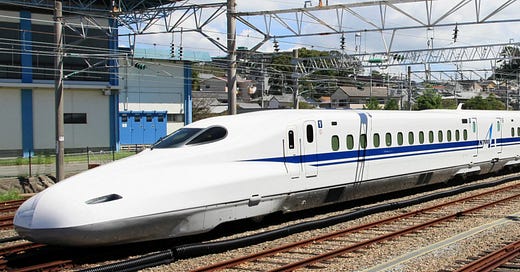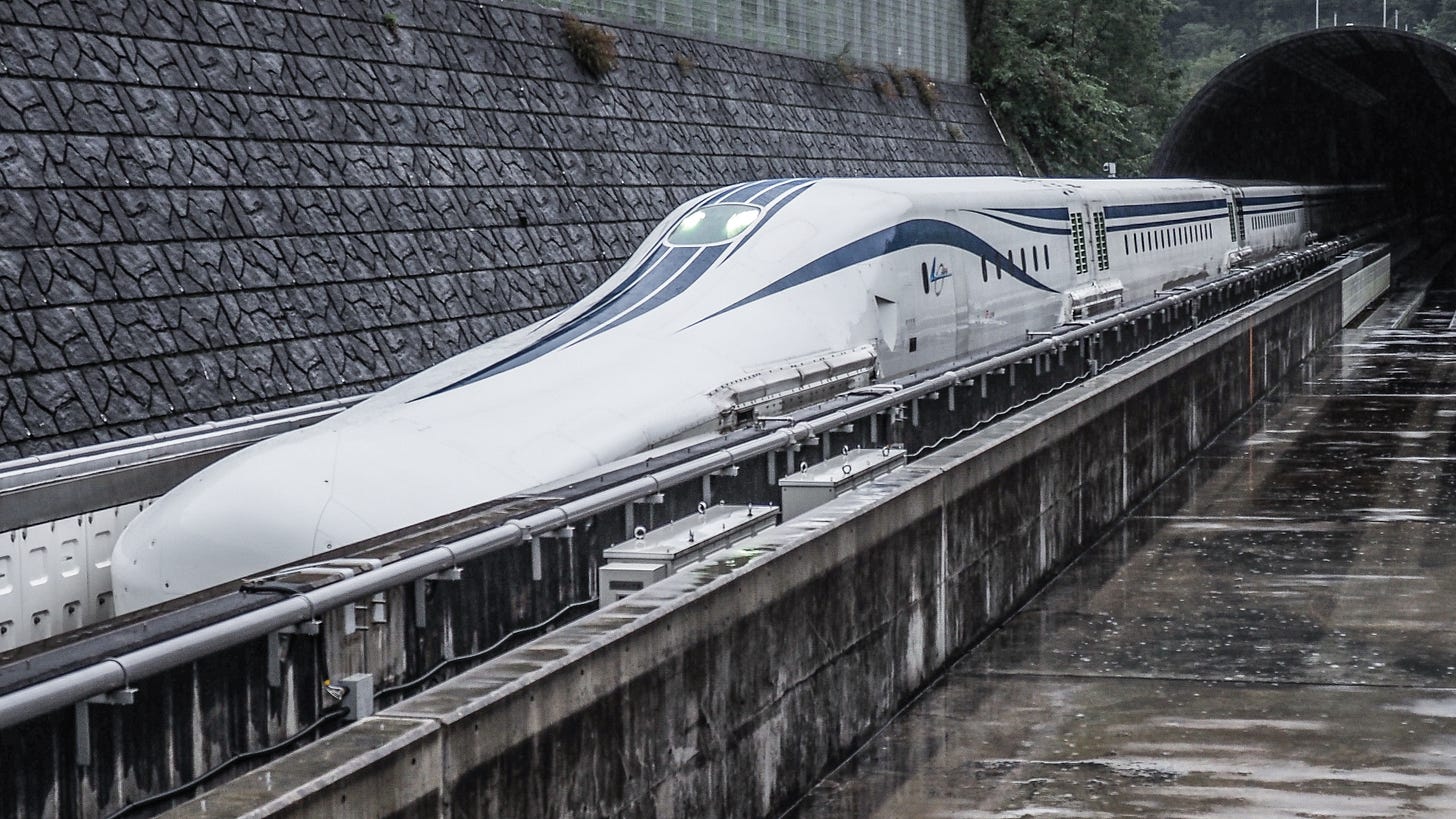Japan's $65BN Bet on Levitating Trains
Will the fastest commercial train in the world make Japan a superpower again?
This is a Japanese bullet train.
If you want to get somewhere in this country faster than a freaking airplane(!), then it’s got you covered. An engineering marvel forged in the aftermath of the Second World War, the Shinkansen has carried more than 10 billion passengers at speeds of up 320 km/h and helped create the world’s third largest economy.
But that’s not enough for Japan. The country is now building the world’s fastest passenger train, a system that will move at twice the speed of the Shinkansen and cut journey time from Tokyo to Osaka in half, all by doing away with one fairly fundamental component: Wheels.
Using magnetic levitation, these new trains will hover ten centimeters above ground, eliminating the friction that comes from being in contact with the rails, and hence being able to reach speeds never seen with trains before.
However, the new line has proved deeply controversial. Grappling with delays, an insane $65BN mountain of construction costs, and a fierce debate over environmental concerns, the project is not exactly the smooth ride the Japanese government was hoping for.
Japan kind of knows a thing or two about trains
The country was the first in the world to develop high-speed rail, with construction of the Tokaido Shinkansen line between Tokyo and Osaka in 1959.
Back then, the Japanese people, and indeed the rest of the world, were skeptical of the country’s massive investment into rail and many thought it would soon be outdated in an exciting new era of air travel and highways.
Nevertheless, the first high-speed line opened in October 1964, ready for Tokyo’s first hosting of the Olympics.
It cut the travel time between Japan’s two biggest cities from nearly seven hours to under four. Proving an instant success, the line served more than 100 million passengers in less than three years and paved the way for Japan not only to be a railway superpower, but an economic powerhouse.
With Levitating train technology, Japan is hoping to replicate the Tokaido Shinkansen Success
This year, Japan hosted the Olympics for the second time, and once again the country was hoping to garner the world’s attention with their next massive leap in train technology: The Chūō Shinkansen!
The 2021 Olympics wasn’t exactly the mega success of the 1964 one, but at least the train is still on track!
When the new Chūō Shinkansen line completes, it will only take 67 minutes from Tokyo to Osaka. At full speed the Chūō Shinkansen trains will move at 500 km/h, although a 2015 test run hit a world-record 603 km/h.
The technology has actually been around since the early 1900s. In fact, concepts for magnetic levitation, or “maglev”, trains date back to the 60s and the world’s first (and so far only) commercial maglev line has been in operation since 2004, running between Shanghai’s city center and its airport.
The Central Japan Railway Company, or JR Central, has modernized this technology using superconducting magnets. Electromagnets are cooled to -269 degrees Celsius, allowing trains to levitate higher above the tracks; but the trains need to be moving at speed before the magnets come in. Once the train reaches 150 km/h by itself, maglev kicks in and the carriage is lifted off its rubber wheels.
The train then interacts with a set of coils in the track, one used to levitate its mass, and the other to propel it forward. Now, without the wheels, the carriages can travel at incredible speeds. The trains are also completely autonomous, controlled by the track, rather than a driver. This measure makes collisions or accidents far less likely.
Unlike the existing bullet trains whose tracks hug the Japanese coastline, Chūō Shinkansen will be 90% underground, cutting beneath the Japanese Southern Alps.
Why is the train track 90% underground?
The reasons for this are twofold:
Firstly, maglev trains work better when they travel in the straightest line possible, and burrowing beneath the mountains avoids Japan’s more earthquake-prone coast. Although, in taking this approach JR Central has ended-up digging some of the deepest tunnels Japan has ever seen.
That’s raised a number of environmental concerns, especially in Shizuoka Prefecture where tunneling threatens the basin of the Ōi River, a major water source for the region.
While environmental studies have found that the risk of disturbing the basin is low, Local governments have criticized these reports for being “insufficient and hasty".
Spokes in the wheels like this combined with unexpected hurdles in the construction of new stations has taken the project’s cost from $13.7BN to a staggering $64BN, making it one of the most expensive megaprojects ever undertaken. The hefty price tag is now leading many in Japan to question whether the new line is worth it at all.
Also, there are a some big drawbacks to Japan’s maglev technology. Once completed, it will be more expensive to run than regular high-speed trains as they consume almost 4x more energy .
The trains also won’t be able to hold as many passengers within their smaller carriages and won’t be able to travel as frequently. Traditional bullet trains run on the Tokyo-Osaka line roughly every three minutes. Because maglev track switches take more time it will only be possible to run a maglev train once every ten minutes.
Japanese rail companies have also previously been able to make back a lot of money by selling their technology overseas. But a noticeable new player has emerged on the scene since the advent of the first bullet train back in 1964: China. It’s now the king of high-speed rail and the country is home to two-thirds of the world’s entire high-speed network.
China is beginning to develop its own version of the technology. In July 2021 it tested a maglev train that reached 600 km/h, almost breaking the record set by Japan. That train could theoretically travel from Beijing to Shanghai in three and half hours, faster than the four and half hours it takes by plane.
Thus, China doesn’t need to buy Japan’s technology, and the rest of the developed world is still playing catch-up with regular high-speed rail.
So why is Japan so intent on building this maglev line?
If Chūō Shinkansen is successful, it has the potential to create a commutable distance between the country’s two largest cities, linking the regions of Tokyo and Osaka in a pretty profound way. It’s a prize that’s becoming increasingly alluring around the world.
Imagining being able to live in Washington and commute daily to New York in less time than your daily commute inside New York today!
Merging major cities like this has the potential to create economic powerhouses on a scale we’ve never seen before.
When the bullet train first began construction more than half a century ago, the world ridiculed it. But it ultimately allowed Japan to grow, connecting regions and sharing prosperity.
In the decade that followed it’s opening, Japan went from an economy that was just 10 percent the size of the US to the world’s second largest. If this technological bet pays off like Shinkansen did in 1964, it could propel Japan yet again to become a superpower to be reckoned with.
So you can see why the Japanese government is willing to bet so much cash on the Chūō Shinkansen maglev technology.
The question is, will anybody want levitating trains?





